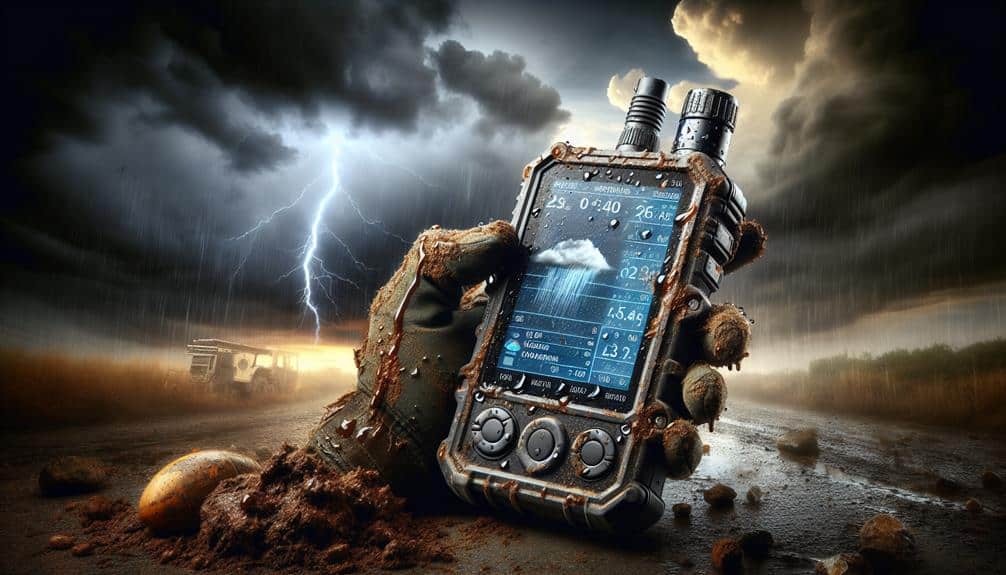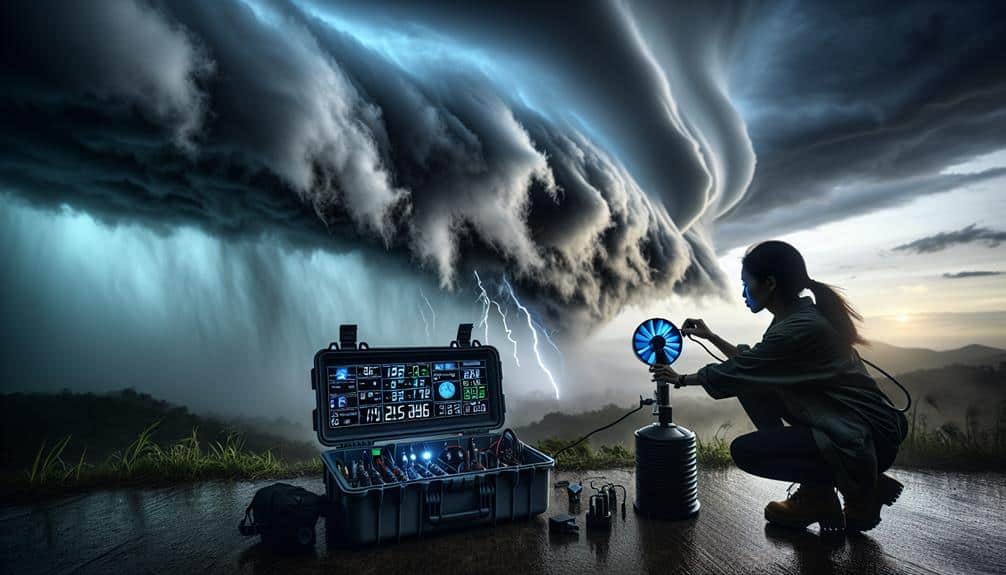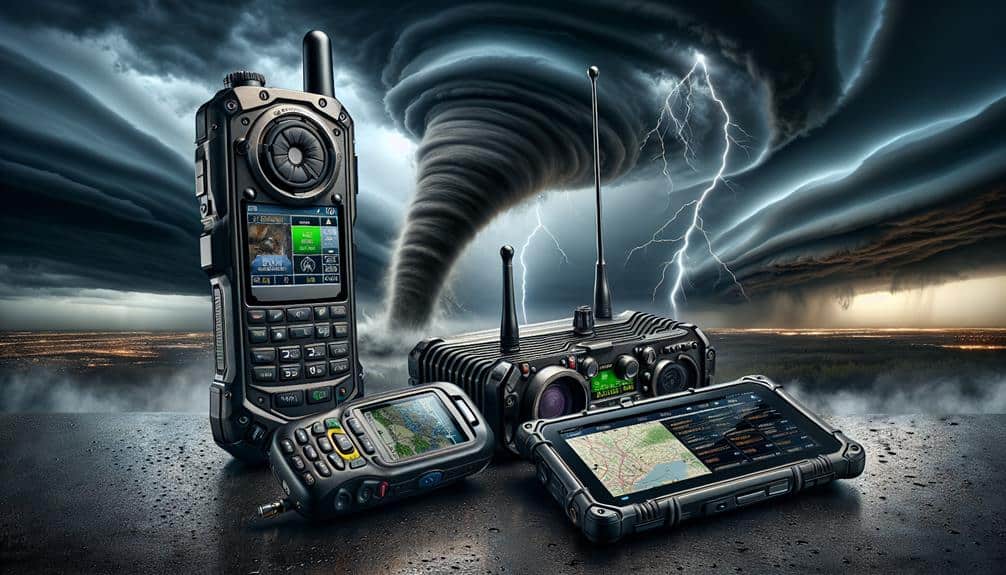For storm chasers, our portable weather stations need to be excellent. Start by selecting the right model based on accuracy, durability, and connectivity. Invest in a strong battery backup, possibly integrating solar power. Durability is crucial—opt for weatherproof and impact-resistant casings. Regular calibration for sensors, especially for temperature, humidity, and wind speed, ensures precise readings. Use reliable software and keep data accurate by frequently updating firmware. Monitor wind speed by installing the anemometer correctly and tracking historic data. Remember, continual maintenance and check-ups keep everything running smoothly. Let's dive deep into each tip to enhance our storm-chasing efficiency.
Key Points
- Ensure your weather station has a robust battery backup and consider integrating solar power for extended field operations.
- Opt for a weather station with weatherproof, impact-resistant casing to withstand harsh storm conditions.
- Regularly calibrate sensors and maintain a log to ensure accurate and reliable data collection.
- Utilize data logging features to track and analyze historical wind speed and direction for improved storm prediction.
Choose the Right Model
Choosing the proper portable weather station involves evaluating key features like sensor accuracy, durability, and connectivity options. We must first consider our budget and the important features that match it. While high-end models offer advanced functionalities, they can strain our finances. On the other hand, budget-friendly options might lack specific features but still provide essential data.
Size options also play a pivotal role in our decision-making. Compact models offer significant portability benefits, making them easy to transport and set up in various locations. Larger units, though potentially more cumbersome, often come with enhanced capabilities and better sensor arrays. We need to balance these aspects based on our specific needs and usage scenarios.
Sensor accuracy is non-negotiable. Accurate measurement of temperature, humidity, wind speed, and atmospheric pressure is essential for reliable data. Durability is another vital factor; our weather station needs to withstand harsh environmental conditions. Robust construction materials and weatherproof designs ensure longevity.
Connectivity options, including Bluetooth, Wi-Fi, and cellular networks, allow seamless data transmission to our devices. This feature is vital for real-time updates and remote monitoring. By carefully evaluating these factors, we can select the right portable weather station that fits our needs and budget.
Ensure Battery Backup
When we rely on portable weather stations, ensuring a robust battery backup is essential.
We need to choose a reliable power source and always carry extra batteries to avoid interruptions.
This preparation guarantees continuous operation and accurate data collection.
Choose Reliable Power Source
To safeguard continuous operation of your portable weather station, we must prioritize selecting a reliable power source with a robust battery backup. Relying solely on a single power source can be risky, especially in unpredictable storm-chasing scenarios.
Integrating solar power into our setup allows for continuous, renewable energy, reducing dependency on traditional power sources. Solar panels can be compact and lightweight, making them ideal for portable use. However, solar power alone mightn't suffice during prolonged periods of cloud cover or nighttime operation.
To address these limitations, incorporating a backup generator guarantees we've an alternative power source when solar energy isn't available. Modern backup generators are increasingly efficient and can be fitted with inverters to provide clean, stable power to sensitive electronic equipment.
Additionally, choosing a generator with dual-fuel capability (gasoline and propane) offers flexibility, allowing us to adapt to fuel availability on the go.
Carry Extra Batteries
Optimizing we carry additional batteries is vital for maintaining uninterrupted operation during extensive fieldwork. Battery life is unpredictable, especially under severe weather conditions. By equipping ourselves with extra batteries, we can optimize that our portable weather stations remain functional, providing essential data when we need it most.
In storm chasing, emergency preparedness isn't just a precaution; it's a necessity. Extra batteries act as a safeguard against unforeseen power shortages. We must consider the battery consumption rates of our devices and calculate the required number of spare batteries accordingly. This proactive approach helps us avoid the pitfalls of dead equipment during critical moments.
Furthermore, it's advisable to invest in high-capacity, rechargeable batteries. These not only offer extended battery life but also reduce the frequency of replacements, making our operations more efficient. Regularly checking and testing our backup batteries ensures they're in peak condition, ready for deployment at any time.
Prioritize Durability

Choosing a portable weather station requires us to prioritize durability to guarantee it withstands harsh environmental conditions. We're often out in the field facing unpredictable weather, so our equipment must be both reliable and resilient.
A weatherproof casing guarantees that our device remains operational even during heavy rain or snow, making it long-lasting. Additionally, impact resistance is vital; a rugged design can handle the inevitable bumps and drops that occur during storm chasing.
When evaluating durability, consider these essential features:
- Weatherproof casing: Protects against water, dust, and debris, ensuring the device operates in various conditions.
- Impact resistance: A rugged design can absorb shocks from falls or collisions, preventing damage to internal components.
- Temperature tolerance: Confirm the device functions accurately across a wide range of temperatures, from freezing cold to scorching heat.
- Sturdy mounting options: Secure attachment points and durable mounts prevent the station from being dislodged by strong winds or vibrations.
Calibrate Regularly
Regular adjustment of our portable weather station guarantees the accuracy and reliability of the data we collect in the field. Without consistent fine-tuning, our sensor precision can diminish, leading to incorrect readings that could jeopardize our storm-chasing efforts. We must treat adjustment as a vital routine, akin to checking our vehicle before a chase.
Let's explore the specifics: adjustment frequency directly impacts the performance of our weather instruments. For instance, temperature and humidity sensors typically require readjustment every six months, while barometric pressure sensors may need it annually. By adhering to these intervals, we secure our instruments provide precise and trustworthy data.
Moreover, environmental factors like extreme temperatures, humidity, and physical impacts can alter sensor accuracy. We should always recalibrate our devices after exposure to such conditions. Utilizing a reliable reference standard during adjustment is essential. This guarantees our instruments align with known values, enhancing their accuracy.
To implement this effectively, we can maintain a log of adjustment dates and procedures. This record helps us track the adjustment frequency and ensures no sensor is neglected.
Monitor Wind Speed

Keeping a close watch on wind velocity is vital for accurately predicting and understanding storm patterns. When we monitor wind velocity, we're not just observing numbers; we're interpreting crucial data that can inform our next action.
Wind velocity, coupled with wind direction analysis, helps us anticipate the intensity and trajectory of a storm. This real-time information is crucial for issuing extreme weather alerts and ensuring we stay safe while pursuing storms.
To effectively monitor wind velocity using a portable weather station, we should focus on the following:
- Install the anemometer correctly: Place it at an appropriate height with no obstructions.
- Regularly check calibration: Regular calibration guarantees precise wind velocity readings.
- Utilize data logging features: Track and analyze historical wind velocity data to identify trends.
- Combine with wind direction analysis: Understand the complete wind profile for improved storm pattern prediction.
Track Temperature Trends
In addition to monitoring wind speed, tracking temperature trends is essential for thorough weather analysis, helping us predict weather changes with greater accuracy. Accurate temperature monitoring allows us to identify temperature extremes and their potential impact on storm patterns. By continually recording temperature data, we can discern patterns that may indicate the formation of severe weather systems.
Using a portable weather station, we can obtain precise temperature readings at various altitudes and locations. This data helps in understanding how temperature gradients influence storm development. Sharp temperature changes often signify instability in the atmosphere, a key factor in storm formation.
As storm chasers, we must consider the broader implications of our temperature data, particularly in the context of climate change. Monitoring long-term temperature trends can reveal shifts that affect storm frequency and intensity. By correlating temperature data with historical storm patterns, we gain insights into how climate change is altering weather phenomena.
Measure Humidity Levels

Monitoring humidity levels is fundamental for predicting precipitation and understanding atmospheric moisture content. Accurate moisture measurement is a foundation of effective storm prediction and climate monitoring. By maintaining precise humidity control, we can better anticipate weather changes and potential storm developments.
To achieve dependable humidity measurements, let's consider these key points:
- Sensor Selection: Choose high-quality hygrometers or digital humidity sensors for precise readings. Ensure they're compatible with our portable weather stations.
- Placement Matters: Position the sensors away from direct sunlight and sources of artificial heat. This minimizes measurement errors and guarantees more accurate data.
- Regular Calibration: Periodically calibrate sensors to maintain their accuracy. Use calibration kits or reference solutions to adjust the readings as needed.
- Data Logging: Utilize data loggers to track humidity trends over time. This helps identify patterns and correlates with other meteorological data for thorough analysis.
Use Reliable Software
When it comes to using our portable weather station, we need software that guarantees real-time data accuracy and a user-friendly interface.
Reliable software allows us to make timely decisions based on precise weather conditions.
Let's explore how these features enhance our overall experience and data reliability.
Real-time Data Accuracy
Ensuring real-time data accuracy hinges on our use of dependable software solutions that consistently interpret and display weather metrics accurately. Data interpretation accuracy is paramount for effective storm prediction, and the software we choose plays a pivotal role. By selecting tools that excel in data transmission reliability, we can guarantee our metrics are timely and precise, which is vital for emergency response planning.
To maximize our effectiveness, let's consider these key points:
- Consistent Updates: Our software should provide real-time updates to track storm developments accurately.
- High-Resolution Data: We need high-detail data for precise storm prediction, aiding our decision-making process.
- Robust Algorithms: The software should employ advanced algorithms to enhance data interpretation accuracy.
- Reliable Connectivity: Guarantee the software maintains strong connectivity to avoid data transmission interruptions.
User-friendly Interface
A user-friendly layout is necessary for us to efficiently interpret and act upon weather data, guaranteeing that our software's functionality is both accessible and reliable. The layout design must be intuitive, allowing us to quickly access and understand essential data points without unnecessary complications. This simplicity in design translates into faster decision-making, a critical factor when storm chasing.
User feedback plays a crucial role in refining this layout. By actively listening to the experiences and suggestions from fellow storm chasers, we can identify pain points and areas for improvement. Continuous updates and iterations based on this feedback guarantee that the software evolves to meet our needs more effectively.
Additionally, the software should offer customizable dashboards, enabling us to prioritize the data most relevant to our specific chasing strategies. This level of customization not only enhances usability but also empowers us to adapt to various storm scenarios with greater agility.
Check Data Accuracy

Verifying the accuracy of your portable weather station's data is crucial for reliable weather monitoring and decision-making. Accurate data allows us to interpret weather patterns correctly and make informed decisions during storm chasing. To achieve this, we need to focus on several key factors.
- Check sensor placement: Confirm all sensors are correctly positioned. Incorrect placement can lead to erroneous data. For example, temperature sensors should be shielded from direct sunlight to avoid inflated readings.
- Calibrate instruments: Regularly calibrate your sensors to maintain accuracy. Uncalibrated sensors can drift over time, leading to data inaccuracies.
- Compare with local data: Cross-reference your station's data with local weather reports. Significant discrepancies may indicate an issue with your sensors.
- Monitor trends: Look for consistent patterns in your data. Sudden anomalies often suggest sensor malfunctions or environmental interferences.
Stay Updated on Maintenance
Let's guarantee our portable weather stations function at their best by staying updated on maintenance.
We need to regularly check the batteries, calibrate the sensors, and keep up with firmware updates.
These actions will help maintain data accuracy and extend the device's lifespan.
Regular Battery Checks
Regularly checking the batteries in your portable weather station guarantees continuous and accurate data collection. Let's prioritize battery longevity and performance by establishing a meticulous maintenance schedule. Setting reminders for these checks ensures we're always prepared for any storm-chasing adventure.
To optimize our battery checks, we need to focus on a few key actions:
- Inspect Battery Contacts: Confirm there's no corrosion or debris, which can interfere with performance.
- Test Battery Voltage: Use a multimeter to verify that each battery is within the best voltage range.
- Replace Old Batteries: Swap out batteries that are nearing the end of their lifespan to prevent unexpected failures.
- Monitor Battery Usage: Keep track of how long each battery lasts under different conditions to predict when replacements will be necessary.
Sensor Calibration Frequency
Maintaining our portable weather station's sensors are consistently calibrated is necessary for preserving data accuracy and reliability. Proper sensor maintenance means we'll obtain precise and dependable weather data, which is important when chasing storms.
Calibration frequency can vary depending on the manufacturer's recommendations and how often we use our equipment. However, a general rule is to perform accuracy verification at least once a month, or before any significant storm-chasing expedition.
To stay on top of calibration, we should set up calibration reminders. This can be done using digital calendars or specialized apps designed for data monitoring. Regularly updating these reminders ensures we don't miss any maintenance windows.
During calibration, we should compare our sensor readings with a known reference to verify accuracy. This step is essential to catch any discrepancies early and adjust accordingly.
Additionally, keeping a log of all calibration activities will help us track sensor performance over time and identify any recurring issues. By prioritizing sensor maintenance and accuracy verification, we guarantee our data remains reliable, allowing us the freedom to focus on the chase itself.
Regular calibration isn't just a task; it's an essential part of our storm-chasing strategy.
Firmware Update Routine
While calibrating sensors is essential for data accuracy, maintaining our portable weather station's firmware updated is equally significant to guarantee peak performance and functionality. Regular firmware updates guarantee that we've the latest features, improved data security, and enhanced remote monitoring capabilities.
Here are some key practices for maintaining our firmware:
- Set Regular Update Intervals: Establish a routine schedule to check for firmware updates. This keeps our system current and prevents lapses in performance.
- Backup Data: Before updating, always back up our data to avoid any loss during the update process.
- Check Release Notes: Read the release notes to understand what changes or improvements the new firmware brings. This helps us anticipate any adjustments needed in our monitoring setup.
- Secure Connections: Make sure we use a secure internet connection during updates to protect against data breaches and maintain the integrity of the firmware.
Frequently Asked Questions
How Can I Protect My Weather Station From Extreme Weather Conditions?
To protect our weather station from extreme conditions, we can use weatherproofing techniques like sealing enclosures and applying UV-resistant coatings. Regular equipment maintenance, such as checking seals and connections, maintains durability and peak performance.
What Are the Benefits of Portable Weather Stations for Storm Chasing?
We can't stress enough how portable weather stations offer real-time monitoring, ensuring data accuracy and accessibility. This lets us take safety precautions on the fly, keeping us as safe as houses while chasing storms.
Are There Any Legal Restrictions on Using Portable Weather Stations?
We must consider the legal implications of data collection and privacy concerns when using portable weather stations. While public use is generally allowed, specific regulations may vary by location, so always verify local laws before deployment.
How Do I Transport My Portable Weather Station Safely?
Did you know that 30% of equipment damage occurs during transit? To transport our portable weather station safely, we use robust storage solutions and proven transportation methods, focusing on weatherproofing and regular equipment maintenance.
What Should I Do if My Weather Station Loses Signal During a Storm?
If our weather station loses signal during a storm, we should start signal troubleshooting immediately. Follow emergency protocols, focus on reconnecting devices, and consider backup options to guarantee we continue receiving critical data without interruption.


